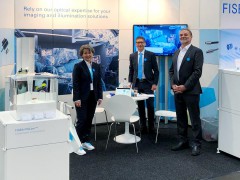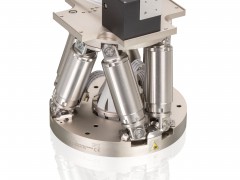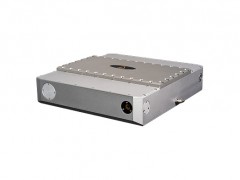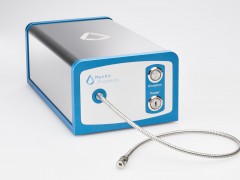
Oxide acquires vacuum ultraviolet laser business of Lumeras
source:Optics.org
release:Nick
keywords: ultraviolet laser Oxide
Time:2018-09-06
Japanese company Oxide based in Yamanashi, has announced the acquisition of the vacuum ultraviolet (VUV) laser business of Lumeras, which is based in Santa Cruz, CA, US. Financial terms of the deal were not revealed.
Oxide, founded in 2000, manufactures deep ultraviolet laser sources across the wavelength range 213-266nm, UV laser sources at 355nm, as well as a variety of high-quality nonlinear optical crystals.
Lumeras, established in 2008, produces high-photon-energy (11eV, 114nm) laser sources, which are typically used in research institutes worldwide for material science applications, including photoemission electron spectroscopy.
With the acquisition of the VUV laser business, Oxide says it has become “the only company in the world having a product portfolio spanning the entire UV-DUV-VUV spectra.”
These very short wavelength laser sources are typically used in research institutes worldwide for cutting-edge material science applications, including photoemission electron spectroscopy.
Lumeras develops, markets, and manufactures short-wavelength laser sources for diverse applications, such as materials characterization, photolithographic metrology, mass spectrometry, and chemical and biological analysis, screening, and detection.
Its VUV laser systems, which Oxide has now purchased, offer compact and coherent line sources for the generation of milliwatt-average powers at photon energies above 10eV, with ultra-narrow-band spectra. For example, the VUV-1 series operate at low repetition rates (sub-100 Hz), while the VUV-2 series are quasi-cw systems with MHz repetition rates.
Oxide’s activities
Oxide’s manufacturing capabilities range from crystal growth of both LN (magnesium-doped LiNbO3) and LT (magnesium-doped congruent LiTaO3); the wafering process itself, QPM device (quasi-phase matching) photonics device development; and the design and fabrication of QPM-device-integrated modules – all in the company’s own Yamanashi Factory.
The company’s website states, “Our profound knowledge of wafer properties help us produce better QPM devices and our deep understanding of QPM devices enables us high-performance wavelength-conversion modules. With our integrated production system and wide technology background, Oxide can answer the requirements from the customers in a ever more efficient and cost effective way and at higher level.”
In 2016, Lumeras' development of a “High Resolution Angle Resolved Photoemission with Tabletop 11eV Laser” was reported in an AIP paper of the same name. The development team commented, “We developed a table-top vacuum ultraviolet laser with 114 nm wavelength (equivalent to 10.897eV) and demonstrated its viability as a photon source for high resolution angle-resolved photoemission spectroscopy (ARPES).
“The system utilizes the ninth harmonics of a 1024 nm IR laser to produce the 113.778 nm VUV radiation for photoemission. Combined with a Scienta R8000 hemispherical electron analyzer, we demonstrate the system’s energy resolution of 2 meV and momentum resolution of 0.012 Å-1 under realistic experimental conditions.”
In terms of applications, this system provides a “long desired solution” to bridging the gap between the existing high-resolution small-momentum-coverage laser-based ARPES and large-momentum-coverage synchrotron-based ARPES.
It is capable of producing high-resolution spectra in many correlated electron systems and reaching their BZ boundaries as well as valence bands, including the temperature dependent CDW gap in rare earth metal tritelluride, the antinode and oxygen 2p band spectrum in cuprate superconductor and superconducting gap measurements in iron-pnictide and iron-chalcogenide film.
- RoboSense is to Produce the First Chinese Multi-beam LiDAR
- China is to Accelerate the Development of Laser Hardening Application
- Han’s Laser Buys Canadian Fiber Specialist CorActive
- SPI Lasers continues it expansion in China, appointing a dedicated Sales Director
- Laser Coating Removal Robot for Aircraft
 FISBA exhibits Customized Solutions for Minimally Invasive Medical Endoscopic Devices at COMPAMED in
FISBA exhibits Customized Solutions for Minimally Invasive Medical Endoscopic Devices at COMPAMED in New Active Alignment System for the Coupling of Photonic Structures to Fiber Arrays
New Active Alignment System for the Coupling of Photonic Structures to Fiber Arrays A new industrial compression module by Amplitude
A new industrial compression module by Amplitude Menhir Photonics Introduces the MENHIR-1550 The Industry's First Turnkey Femtosecond Laser of
Menhir Photonics Introduces the MENHIR-1550 The Industry's First Turnkey Femtosecond Laser of Shenzhen DNE Laser introduced new generation D-FAST cutting machine (12000 W)
more>>
Shenzhen DNE Laser introduced new generation D-FAST cutting machine (12000 W)
more>>

